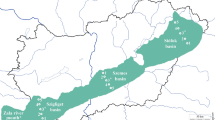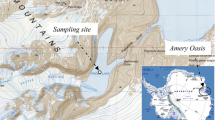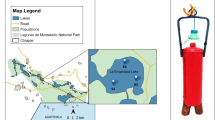Abstract
Although freshwater biomes cover less than 1% of the Earth’s surface, they have disproportionate ecological significances. Attempts to study the taxonomy and function of freshwater microbiota are currently limited to samples collected from temperate lakes. In this study, we investigated samples from the photic and aphotic of an aquaculture site (disturbed) of Temengor Lake, a tropical lake in comparison with the undisturbed site of the lake using 16S rRNA amplicon and shotgun metagenomic approaches. Vertical changes in bacterial community composition and function of the Temengor Lake metagenomes were observed. The photic water layer of Temengor Lake was dominated by typical freshwater assemblages consisting of Proteobacteria, Actinobacteria, Bacteroidetes, Verrucomicrobia, and Cyanobacteria lineages. On the other hand, the aphotic water featured in addition to Proteobacteria, Bacteroidetes, Verrucomicrobia, and two more abundant bacterial phyla that are typically ubiquitous in anoxic habitats (Chloroflexi and Firmicutes). The aphotic zone of Temengor Lake exhibited genetic potential for nitrogen and sulfur metabolisms for which terminal electron acceptors other than oxygen are used in the reactions. The aphotic water of the disturbed site also showed an overrepresentation of genes associated with the metabolism of carbohydrates, likely driven by the enrichment of nutrient resulting from aquaculture activities at the site. The results presented in this study can serve as a basis for understanding the structure and functional capacity of the microbial communities in the photic and aphotic zones/water layers of tropical man-made lakes.






Similar content being viewed by others
References
Lindström ES, Feng XM, Granéli W, Kritzberg ES (2010) The interplay between bacterial community composition and the environment determining function of inland water bacteria. Limnol. Oceanogr. 55:2052–2060
Lindström ES, Kamst-Van Agterveld MP, Zwart G (2005) Distribution of typical freshwater bacterial groups is associated with pH, temperature, and lake water retention time. Appl. Environ. Microbiol. 71:8201–8206
Yannarell AC, Triplett EW (2005) Geographic and environmental sources of variation in lake bacterial community composition. Appl. Environ. Microbiol. 71:227–239
García Molinos J, Viana M, Brennan M, Donohue I (2015) Importance of long-term cycles for predicting water level dynamics in natural lakes. PLoS One 10:e0119253
Newton RJ, Jones SE, Eiler A, McMahon KD, Bertilsson S (2011) A guide to the natural history of freshwater lake bacteria. Microbiol. Mol. Biol. Rev. 75:14–49
Sunagawa S, Coelho LP, Chaffron S, Kultima JR, Labadie K, Salazar G, Djahanschiri B, Zeller G, Mende DR, Alberti A, Cornejo-Castillo FM, Costea PI, Cruaud C, d'Ovidio F, Engelen S, Ferrera I, Gasol JM, Guidi L, Hildebrand F, Kokoszka F, Lepoivre C, Lima-Mendez G, Poulain J, Poulos BT, Royo-Llonch M, Sarmento H, Vieira-Silva S, Dimier C, Picheral M, Searson S, Kandels-Lewis S, Tara Oceans coordinators, Bowler C, de Vargas C, Gorsky G, Grimsley N, Hingamp P, Iudicone D, Jaillon O, Not F, Ogata H, Pesant S, Speich S, Stemmann L, Sullivan MB, Weissenbach J, Wincker P, Karsenti E, Raes J, Acinas SG, Bork P, Boss E, Bowler C, Follows M, Karp-Boss L, Krzic U, Reynaud EG, Sardet C, Sieracki M, Velayoudon D (2015) Structure and function of the global ocean microbiome. Science 348:1261359
Martín-Cuadrado A-B, López-García P, Alba J-C, Moreira D, Monticelli L, Strittmatter A, Gottschalk G, Rodríguez-Valera F (2007) Metagenomics of the deep Mediterranean, a warm bathypelagic habitat. PLoS One 2:e914
Yergeau E, Michel C, Tremblay J, Niemi A, King TL, Wyglinski J, Lee K, Greer CW (2017) Metagenomic survey of the taxonomic and functional microbial communities of seawater and sea ice from the Canadian Arctic. Sci. Rep. 7:42242
Ghai R, Rodŕíguez-Valera F, McMahon KD, Toyama D, Rinke R, Cristina Souza de Oliveira T et al (2011) Metagenomics of the water column in the pristine upper course of the Amazon river. PLoS One 6:e23785
Debroas D, Humbert JF, Enault F, Bronner G, Faubladier M, Cornillot E (2009) Metagenomic approach studying the taxonomic and functional diversity of the bacterial community in a mesotrophic lake (Lac du Bourget--France). Environ. Microbiol. 11:2412–2424
Oh S, Caro-Quintero A, Tsementzi D, DeLeon-Rodriguez N, Luo C, Poretsky R, Konstantinidis KT (2011) Metagenomic insights into the evolution, function, and complexity of the planktonic microbial community of Lake Lanier, a temperate freshwater ecosystem. Appl. Environ. Microbiol. 77:6000–6011
Rusch DB, Halpern AL, Sutton G, Heidelberg KB, Williamson S, Yooseph S, Wu D, Eisen JA, Hoffman JM, Remington K, Beeson K, Tran B, Smith H, Baden-Tillson H, Stewart C, Thorpe J, Freeman J, Andrews-Pfannkoch C, Venter JE, Li K, Kravitz S, Heidelberg JF, Utterback T, Rogers YH, Falcón LI, Souza V, Bonilla-Rosso G, Eguiarte LE, Karl DM, Sathyendranath S, Platt T, Bermingham E, Gallardo V, Tamayo-Castillo G, Ferrari MR, Strausberg RL, Nealson K, Friedman R, Frazier M, Venter JC (2007) The Sorcerer II Global Ocean sampling expedition: northwest Atlantic through eastern tropical Pacific. PLoS Biol. 5:e77
Gabriel Z, Byron CC, Miranda PK-vA, Ferry H, Suk-Kyun H (2002) Typical freshwater bacteria: an analysis of available 16S rRNA gene sequences from plankton of lakes and rivers. Aquat. Microb. Ecol. 28:141–155
SM M, Jakob P, Thomas P (2010) Spatiotemporal distribution and activity patterns of bacteria from three phylogenetic groups in an oligomesotrophic lake. Limnol. Oceanogr. 55:846–856
Amarasinghe US, De Silva SS (2015). Fishes and fisheries of Asian inland lacustrine waters. In Freshwater Fisheries Ecology, J. F. Craig (Ed.). https://doi.org/10.1002/9781118394380.ch31
Dahlen BF (1993) Hydropower in Malaysia. Tenaga Nasional Berhad (TNB), Bangsar 184 p
Abdul Rashid AM (2016) Private sector participation on forest conservation in Malaysia-Pulau Banding foundation story, Marrakesh, Morocco
Klindworth A, Pruesse E, Schweer T, Peplies J, Quast C, Horn M, Glöckner FO (2013) Evaluation of general 16S ribosomal RNA gene PCR primers for classical and next-generation sequencing-based diversity studies. Nucleic Acids Res. 41:e1–e1
Li Y-L, Weng J-C, Hsiao C-C, Chou M-T, Tseng C-W, Hung J-H (2015) PEAT: an intelligent and efficient paired-end sequencing adapter trimming algorithm. BMC Bioinformatics 16:S2
Bushnell B, Rood J, Singer E (2017) BBMerge – accurate paired shotgun read merging via overlap. PLoS One 12:e0185056
Edgar RC, Haas BJ, Clemente JC, Quince C, Knight R (2011) UCHIME improves sensitivity and speed of chimera detection. Bioinformatics 27:2194–2200
Caporaso JG, Kuczynski J, Stombaugh J, Bittinger K, Bushman FD, Costello EK, Fierer N, Peña AG, Goodrich JK, Gordon JI, Huttley GA, Kelley ST, Knights D, Koenig JE, Ley RE, Lozupone CA, McDonald D, Muegge BD, Pirrung M, Reeder J, Sevinsky JR, Turnbaugh PJ, Walters WA, Widmann J, Yatsunenko T, Zaneveld J, Knight R (2010) QIIME allows analysis of high-throughput community sequencing data. Nat Methods 7:335–336
Clarke KR, Gorley RN, Somerfield PJ, WR M (2014) Change in marine communities: an approach to statistical analysis and interpretation. Primer-E Ltd, Plymouth
Li D, Liu CM, Luo R, Sadakane K, Lam TW (2015) MEGAHIT: an ultra-fast single-node solution for large and complex metagenomics assembly via succinct de Bruijn graph. Bioinformatics 31:1674–1676
Meyer F, Paarmann D, D'Souza M, Olson R, Glass EM, Kubal M, Paczian T, Rodriguez A, Stevens R, Wilke A, Wilkening J, Edwards RA (2008) The metagenomics RAST server - a public resource for the automatic phylogenetic and functional analysis of metagenomes. BMC Bioinformatics 9:386
Parks DH, Tyson GW, Hugenholtz P, Beiko RG (2014) STAMP: statistical analysis of taxonomic and functional profiles. Bioinformatics 30:3123–3124
Wang NF, Zhang T, Yang X, Wang S, Yu Y, Dong LL et al (2016) Diversity and composition of bacterial community in soils and lake sediments from an Arctic lake area. Front. Microbiol. 7:1170
Fang L, Chen L, Liu Y, Tao W, Zhang Z, Liu H, Tang Y (2015) Planktonic and sedimentary bacterial diversity of Lake Sayram in summer. Microbiologyopen 4:814–825
Yannarell AC, Kent AD (2010) Bacteria, distribution and community structure. In: Likens GE (ed) Plankton of inland waters. Academic, San Diego
Biderre-Petit C, Dugat-Bony E, Mege M, Parisot N, Adrian L, Moné A, Denonfoux J, Peyretaillade E, Debroas D, Boucher D, Peyret P (2016) Distribution of Dehalococcoidia in the anaerobic deep water of a remote meromictic crater lake and detection of Dehalococcoidia-derived reductive dehalogenase homologous genes. PLoS One 11:e0145558
Simon C, Wiezer A, Strittmatter AW, Daniel R (2009) Phylogenetic diversity and metabolic potential revealed in a glacier ice metagenome. Appl. Environ. Microbiol. 75:7519–7526
Llirós M, Inceoğlu Ö, García-Armisen T, Anzil A, Leporcq B, Pigneur L-M, Viroux L, Darchambeau F, Descy JP, Servais P (2014) Bacterial community composition in three freshwater reservoirs of different alkalinity and trophic status. PLoS One 9:e116145
Knief C (2015) Diversity and habitat preferences of cultivated and uncultivated aerobic methanotrophic bacteria evaluated based on pmoA as molecular marker. Front. Microbiol. 6:1346
Kleindienst S, Herbst F-A, Stagars M, von Netzer F, von Bergen M, Seifert J, Peplies J, Amann R, Musat F, Lueders T, Knittel K (2014) Diverse sulfate-reducing bacteria of the Desulfosarcina/Desulfococcus clade are the key alkane degraders at marine seeps. ISME J 8:2029–2044
Thomas F, Hehemann J-H, Rebuffet E, Czjzek M, Michel G (2011) Environmental and gut Bacteroidetes: the food connection. Front. Microbiol. 2:93
Caumette P, Brochier-Armanet C, Normand P (2015) Taxonomy and phylogeny of prokaryotes. In: Bertrand J-C, Caumette P, Lebaron P, Matheron R, Normand P et al (eds) Environmental Microbiology: Fundamentals and Applications: Microbial Ecology. Springer Netherlands, Dordrecht, pp 145–190
Bragg JG, Wagner A (2009) Protein material costs: single atoms can make an evolutionary difference. Trends Genet. 25:5–8
Barberan A, Casamayor EO (2011) Euxinic freshwater hypolimnia promote bacterial endemicity in continental areas. Microb. Ecol. 61:465–472
Cole JJ, Pace ML, Caraco NF, Steinhart GS (1993) Bacterial biomass and cell size distributions in lakes: more and larger cells in anoxic waters. Limnol. Oceanogr. 38:1627–1632
Glöckner FO, Zaichikov E, Belkova N, Denissova L, Pernthaler J, Pernthaler A et al (2000) Comparative 16S rRNA analysis of lake bacterioplankton reveals globally distributed phylogenetic clusters including an abundant group of Actinobacteria. Appl. Environ. Microbiol. 66:5053–5065
Hahn MW, Lunsdorf H, Wu Q, Schauer M, Hofle MG, Boenigk J, Stadler P (2003) Isolation of novel ultramicrobacteria classified as Actinobacteria from five freshwater habitats in Europe and Asia. Appl. Environ. Microbiol. 69:1442–1451
Langenheder S, Jürgens K (2001) Regulation of bacterial biomass and community structure by metazoan and protozoan predation. Limnol. Oceanogr. 46:121–134
Jezbera J, Sharma AK, Brandt U, Doolittle WF, Hahn MW (2009) ‘Candidatus Planktophila limnetica’, an actinobacterium representing one of the most numerically important taxa in freshwater bacterioplankton. Int. J. Syst. Evol. Microbiol. 59:2864–2869
Warnecke F, Sommaruga R, Sekar R, Hofer JS, Pernthaler J (2005) Abundances, identity, and growth state of Actinobacteria in mountain lakes of different UV transparency. Appl. Environ. Microbiol. 71:5551–5559
Ventura M, Canchaya C, Tauch A, Chandra G, Fitzgerald GF, Chater KF, van Sinderen D (2007) Genomics of Actinobacteria: tracing the evolutionary history of an ancient phylum. Microbiol. Mol. Biol. Rev. 71:495–548
Eiler A, Bertilsson S (2007) Flavobacteria blooms in four eutrophic lakes: linking population dynamics of freshwater bacterioplankton to resource availability. Appl. Environ. Microbiol. 73:3511–3518
Zeder M, Peter S, Shabarova T, Pernthaler J (2009) A small population of planktonic Flavobacteria with disproportionally high growth during the spring phytoplankton bloom in a prealpine lake. Environ. Microbiol. 11:2676–2686
Kolmonen E, Sivonen K, Rapala J, Haukka K (2004) Diversity of cyanobacteria and heterotrophic bacteria in cyanobacterial blooms in Lake Joutikas, Finland. Aquat. Microb. Ecol. 36:201–211
Bauer M, Kube M, Teeling H, Richter M, Lombardot T, Allers E, Würdemann CA, Quast C, Kuhl H, Knaust F, Woebken D, Bischof K, Mussmann M, Choudhuri JV, Meyer F, Reinhardt R, Amann RI, Glöckner FO (2006) Whole genome analysis of the marine Bacteroidetes ‘Gramella forsetii’ reveals adaptations to degradation of polymeric organic matter. Environ. Microbiol. 8:2201–2213
Morrison JM, Baker KD, Zamor RM, Nikolai S, Elshahed MS, Youssef NH (2017) Spatiotemporal analysis of microbial community dynamics during seasonal stratification events in a freshwater Lake (Grand Lake, OK, USA). PLoS One 12:e0177488
Eiler A, Bertilsson S (2004) Composition of freshwater bacterial communities associated with cyanobacterial blooms in four Swedish lakes. Environ. Microbiol. 6:1228–1243
Haukka K, Kolmonen E, Hyder R, Hietala J, Vakkilainen K, Kairesalo T, Haario H, Sivonen K (2006) Effect of nutrient loading on bacterioplankton community composition in lake mesocosms. Microb. Ecol. 51:137–146
Van den Wyngaert S, Salcher MM, Pernthaler J, Zeder M, Posch T (2011) Quantitative dominance of seasonally persistent filamentous cyanobacteria (Planktothrix rubescens) in the microbial assemblages of a temperate lake. Limnol. Oceanogr. 56:97–109
Salcher MM, Pernthaler J, Zeder M, Psenner R, Posch T (2008) Spatio-temporal niche separation of planktonic Betaproteobacteria in an oligo-mesotrophic lake. Environ. Microbiol. 10:2074–2086
Salcher MM, Posch T, Pernthaler J (2013) In situ substrate preferences of abundant bacterioplankton populations in a prealpine freshwater lake. ISME J 7:896–907
Salka I, Srivastava A, Allgaier M, Grossart H-P (2014) The draft genome sequence of Sphingomonas sp. strain FukuSWIS1, obtained from acidic Lake Grosse Fuchskuhle, indicates photoheterotrophy and a potential for humic matter degradation. Genome Announc 2:e01183–e01114
Dimitriu PA, Pinkart HC, Peyton BM, Mormile MR (2008) Spatial and temporal patterns in the microbial diversity of a meromictic soda lake in Washington state. Appl. Environ. Microbiol. 74:4877–4888
Frank KL, Rogers DR, Olins HC, Vidoudez C, Girguis PR (2013) Characterizing the distribution and rates of microbial sulfate reduction at Middle Valley hydrothermal vents. ISME J 7:1391–1401
Teske A, Ramsing NB, Habicht K, Fukui M, Kuver J, Jorgensen BB et al (1998) Sulfate-reducing bacteria and their activities in cyanobacterial mats of solar lake (Sinai, Egypt). Appl. Environ. Microbiol. 64:2943–2951
Huang W, Chen X, Jiang X, Zheng B (2017) Characterization of sediment bacterial communities in plain lakes with different trophic statuses. Microbiologyopen 6:e00503
Yang J, Ma L, Jiang H, Wu G, Dong H (2016) Salinity shapes microbial diversity and community structure in surface sediments of the Qinghai-Tibetan Lakes. Sci. Rep. 6:25078
Gyllenhammar A, Hakanson L (2005) Environmental consequence analyses of fish farm emissions related to different scales and exemplified by data from the Baltic--a review. Mar. Environ. Res. 60:211–243
Kawahara N, Shigematsu K, Miyadai T, Kondo R (2009) Comparison of bacterial communities in fish farm sediments along an organic enrichment gradient. Aquaculture 287:107–113
Danovaro R, Corinaldesi C, La Rosa T, Luna GM, Mazzola A, Mirto S et al (2003) Aquaculture impact on benthic microbes and organic matter cycling in coastal Mediterranean sediments: a synthesis. Chem. Ecol. 19:59–65
Tamminen M, Karkman A, Corander J, Paulin L, Virta M (2011) Differences in bacterial community composition in Baltic Sea sediment in response to fish farming. Aquaculture 313:15–23
Tomassetti P, Gennaro P, Lattanzi L, Mercatali I, Persia E, Vani D, Porrello S (2016) Benthic community response to sediment organic enrichment by Mediterranean fish farms: case studies. Aquaculture 450:262–272
Steffen MM, Li Z, Effler TC, Hauser LJ, Boyer GL, Wilhelm SW (2012) Comparative metagenomics of toxic freshwater cyanobacteria bloom communities on two continents. PLoS One 7:e44002
Backer LC, Manassaram-Baptiste D, LePrell R, Bolton B (2015) Cyanobacteria and algae blooms: review of health and environmental data from the harmful algal bloom-related illness surveillance system (HABISS) 2007–2011. Toxins 7:1048–1064
Funding
This project was financially supported by the Research University (RU) project grant (1001/PCCB/870009). Financial support from the Universiti Sains Malaysia research Grant (USM1001/ PBiologi/870039) to A.S.R. Md Sah. was greatly appreciated.
Author information
Authors and Affiliations
Corresponding author
Electronic supplementary material
ESM 1
(PDF 506 kb)
Rights and permissions
About this article
Cite this article
Lau, NS., Zarkasi, K.Z., Md Sah, A.S.R. et al. Diversity and Coding Potential of the Microbiota in the Photic and Aphotic Zones of Tropical Man-Made Lake with Intensive Aquaculture Activities: a Case Study on Temengor Lake, Malaysia. Microb Ecol 78, 20–32 (2019). https://doi.org/10.1007/s00248-018-1283-0
Received:
Accepted:
Published:
Issue Date:
DOI: https://doi.org/10.1007/s00248-018-1283-0




